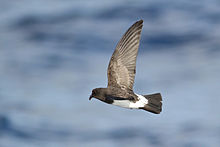Southern petrels
| Southern petrels | ||||||||||||
|---|---|---|---|---|---|---|---|---|---|---|---|---|

Frigate Petrel ( Pelagodroma marina ) |
||||||||||||
| Systematics | ||||||||||||
|
||||||||||||
| Scientific name | ||||||||||||
| Oceanitidae | ||||||||||||
| Forbes , 1821 |
The southern petrels (Oceanitidae) are a family of tubular noses (Procellariiformes) that is widespread on all oceans . The family includes nine species in five genera.
features
Southern petrels are relatively small sea birds ; some species do not grow larger than a swallow. They are usually dark brown or gray in color, with white spots on the face, chest and stomach, rump and the undersides of the wings. The wings are long and narrow but shorter than the wings of the northern petrels (Hydrobatidae). The head is small with a steep profile. The neck is short and thick. The beak is relatively short and slender. It has a hook at the top. The tubular noses open into a single opening. The legs are longer than those of the northern petrels. The three forward-facing toes are webbed together. The sexes hardly differ.
distribution and habitat
Southern petrels come on the Pacific from the coasts of Antarctica to just north of the equator, on the entire Indian Ocean with the exception of the Andaman Sea and on the Atlantic from the Antarctic coast north about up to a line that extends from Brittany to the southeast of Labrador . The greatest biodiversity can be found in the Southern Ocean . While some species have huge action areas outside of the breeding season, their breeding areas are usually limited to a few rock islands. These are mostly on sub-Antarctic islands. For example, the blue-footed petrel only breeds on a few sub-Antarctic islands and on the mainland of Antarctica, but flies over all oceans outside of the breeding season and can penetrate northward to the coasts of Canada and France . However, there are also species that breed in equatorial regions, in one case even in the northern hemisphere ( frigate petrel on the Cape Verde Islands and the Canaries ).
Way of life
The knowledge of the way of life of the southern petrels is based almost exclusively on observations in their breeding colonies. Since petrels scatter in the open sea outside of the breeding season, very little is known about their activity during these phases of life. Although they can swim, they rarely use this skill and spend most of their lives in the air. Typical is the irregular and fluttering flight close to the sea surface. The birds feed on zooplankton , small fish, crustaceans and cephalopods , which they capture with their short beaks in flight just below the surface of the water. This may attract or startle potential prey, making them easier for the petrels to spot.
Southern petrels are monogamous and often form fixed pairs that meet again at the breeding site every year. The birds nest on rocky coasts and on islands in caves and holes in the ground. The female lays a single, very large, white egg, the weight of which is 20 to 30% of her body weight. Both partners breed equally. The breeding biology of the northern petrels is much better known. However, it is believed that the breeding biology of the southern petrel is very similar.
Systematics
Southern petrels are assigned as a family to the tubular noses , which also include albatrosses , petrels and northern petrels . They used to be considered a subfamily of a single family of petrels. However, DNA analyzes led to the result that the petrels do not form a uniform taxon. Only the two subfamilies are monophyletic , but the petrels as a whole are paraphyletic . The southern petrels therefore got the rank of an independent family.


Genera and species
- Genus Oceanites
- Red-footed petrel , O. oceanicus
- Elliot petrel , O. gracilis
- Pincoya tern , O. pincoyae
- Genus Garrodia
- Gray-backed petrel , G. nereis
- Genus Pelagodroma
- Frigate petrel , P. marina
- Genus Fregetta
- White-bellied sea creeper , F. grallaria
- New Zealand petrel , F. maorianus
- Black-bellied sandpiper , F. tropica
- Genus Nesofregetta
- White-throated sandpiper , N. fuliginosa
Danger
As with many other seabird species, the threat to the southern petrels is primarily that the habitat of their breeding islands is directly or indirectly changed by humans. On numerous islands, clutches and young birds are now endangered by rats or cats introduced by humans. The New Zealand petrel , believed to be extinct, was rediscovered in 2003. However, it is still considered critically endangered.
supporting documents
Individual evidence
- ↑ a b c d e f g David W. Winkler, Shawn M. Billerman, Irby J. Lovette: Bird Families of the World: A Guide to the Spectacular Diversity of Birds. Lynx Edicions (2015), ISBN 978-8494189203 , p. 164 and 165.
- ^ Gary Nunn & Scott Stanley: Body size effects and rates of cytochrome b evolution in tube-nosed seabirds . In: Molecular Biology and Evolution 1998, Issue 15 (10), pp. 1360-1371.
- ↑ Hackett et al .: A Phylogenomic Study of Birds Reveals Their Evolutionary History . Science 27 June 2008: Vol. 320. no. 5884, pp. 1763–1768 doi : 10.1126 / science.1157704
- ↑ Fregetta maoriana in the IUCN Red List of Threatened Species . Retrieved November 19, 2011.
Web links
- Austral Storm Petrels Family Oceanitidae IOC World Bird List, accessed December 19, 2019